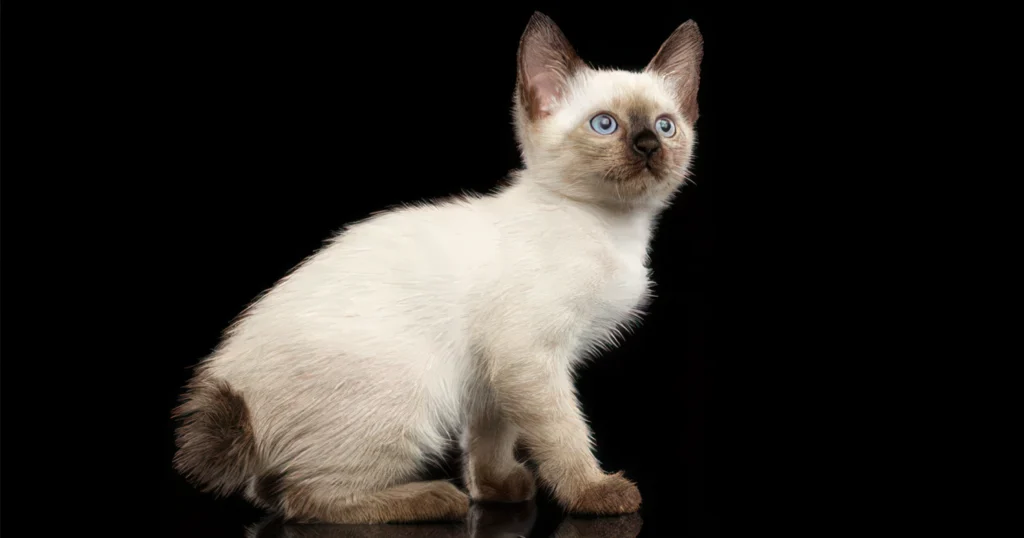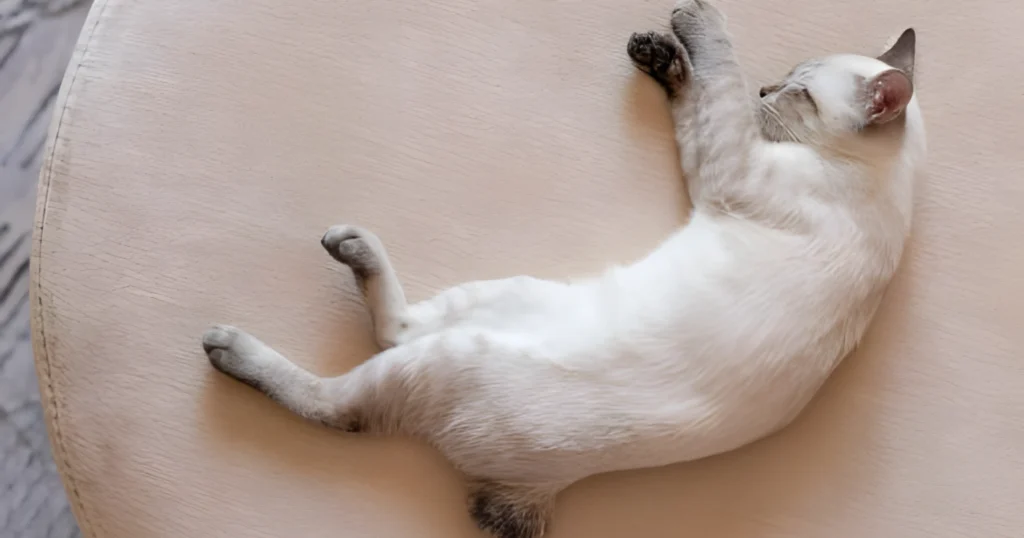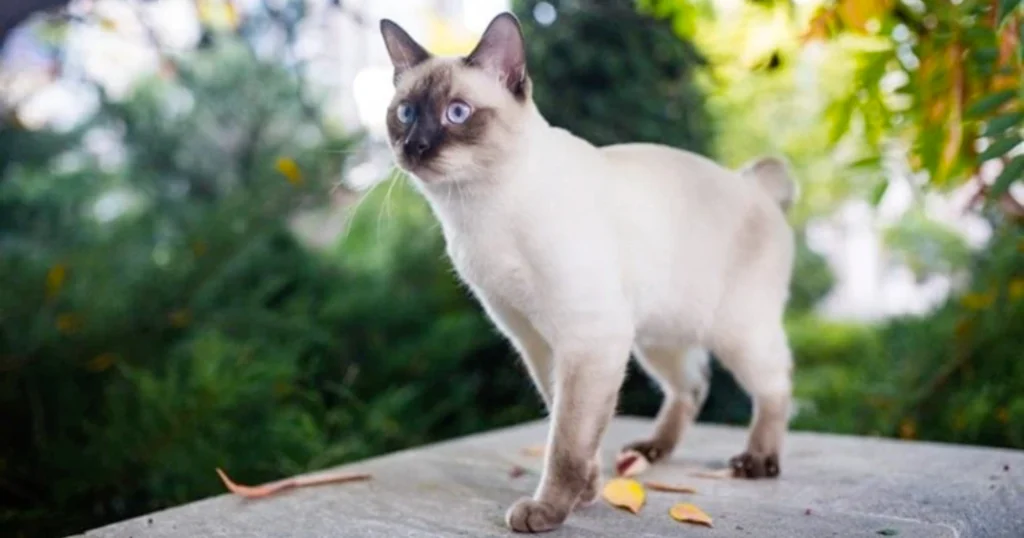With their striking blue eyes, characteristic bobbed tail, and affectionate personality, the Mekong Bobtail is still a relatively rare but increasingly popular cat breed. Originally from Thailand where they were thought to bring good luck, Mekong Bobtails are medium-sized, athletic cats known for forming tight bonds with their human families. While they don’t have any serious breed-specific health issues, these cats do require lots of interaction and stimulation to be happy. If you’re looking for a friendly feline companion to brighten up your home, the Mekong Bobtail may be the perfect choice.
Historical Background of the Mekong Bobtail

The Mekong Bobtail cat traces its origins back to Thailand, where it was first bred as a landrace breed with a natural bobbed tail. Originally called the Thai Bobtail, these cats were prized for their unique tails that curled up at the end, which were thought to bring good luck and prosperity. Native to central and southern Thailand, they likely developed their signature tails due to a spontaneous natural mutation.
These bobtail cats have long been associated with temples, royalty, and the Mekong River region in Thailand. In the late 19th century, the cats so impressed King Rama V of Thailand that he declared them as royal temple cats. The king started to breed the bobtails and gift them to royal families in Europe, including Russia’s Czar Nicholas II.
The Thai Bobtail first arrived in the United States in the 1960s when American servicemen brought them back from Southeast Asia. At first, they were referred to by the generic name “bobtail” until the breed gained recognition.
In 2003, breeders began organizing to establish the Thai cats as a recognized breed. The following year, the World Cat Federation accepted it as a championship breed, calling it the Mekong Bobtail to reflect its heritage along Thailand’s Mekong River valley.
Since gaining championship status, the Mekong Bobtail has grown in popularity beyond its native Thailand. Breeders in the United States and United Kingdom have started Mekong Bobtail breeding programs to expand the gene pool outside of Thailand.
While still considered rare, the Mekong Bobtail is quickly gaining fans around the world. As people discover their affectionate personality, stunning blue eyes, and distinctive tails, Mekong Bobtails are finding their way into more and more households as pedigreed pets.
Physical Characteristics of the Mekong Bobtail

The Mekong Bobtail, with its distinct physical traits, is a sight to behold. Each attribute of this breed, from its medium-sized stature to its glossy coat, contributes to its unique charm and allure. Let’s delve into the physical characteristics that set the Mekong Bobtail apart.
Medium-Sized Stature
The Mekong Bobtail is considered a medium-sized cat breed. Full grown adults typically weigh 8-15 pounds and have a muscular, athletic build. Their medium stature makes them well-suited for an active, energetic lifestyle.
Signature Short, Kinked Tail
The Mekong Bobtail’s most distinguishing feature is its short, kinked tail that resembles a bobtail. The tail is only 1-4 inches long and often curls up at the end. This natural mutation gives the breed a distinctive silhouette.
Glossy, Short Coat
Mekong Bobtails have a short, close-lying coat that shines with a glossy texture. Their fur comes in many colors like brown, blue, lilac, and cream. Daily grooming easily maintains the health of their low-maintenance coat.
Striking Blue Eyes
Perhaps the most striking feature of the Mekong Bobtail is their large, intense blue eyes. Their eyes shine bright azure blue and often have a slightly elongated, almond shape.
Life Expectancy
With proper care, Mekong Bobtails generally live 12-15 years. Lack of serious genetic diseases means their lifespan meets the average life expectancy for domestic cats.
The Mekong Bobtail’s good looks and athletic build make this breed visually stunning. Their signature tails and piercing blue eyes give them an exotic, eye-catching appearance.
Personality Traits of the Mekong Bobtail

If you’re charmed by the Mekong Bobtail’s physical allure, wait until you get to know its personality. This breed is more than just a pretty face—it’s a loyal companion with a heart as big as its history. Let’s explore the delightful personality traits that make the Mekong Bobtail a favorite among cat lovers.
Friendly and Affectionate Nature
Mekong Bobtails are known for their friendly and affectionate demeanor. They’re far from aloof—these cats love to show their affection, often following their humans around the house and seeking out cuddles and playtime.
Loyalty
The loyalty of a Mekong Bobtail is something to be admired. They form strong bonds with their human companions, showing a level of loyalty and devotion that’s truly endearing. A Mekong Bobtail is not just a pet, but a part of the family.
Affinity for Human Interaction
Mekong Bobtails thrive on human interaction. They enjoy being in the company of their human family and are often found in the middle of the household action. Whether it’s curling up on the couch for a movie night or helping you work at your desk, a Mekong Bobtail loves to be involved.
Ability to Form Strong Bonds with Owners
One of the Mekong Bobtail’s most distinctive traits is its ability to form strong bonds with its owners. These cats are known to develop a deep connection with their humans, making them ideal companions for those looking for a pet to form a close relationship with.
Compatibility with Children
Mekong Bobtails are not only great companions for adults but are also compatible with children. Their gentle, playful nature makes them excellent playmates for kids. They can provide endless entertainment and companionship, teaching children about responsibility and the bond between humans and animals.
Health Overview of the Mekong Bobtail

A major factor to consider when choosing a pet is their health status. Luckily, the Mekong Bobtail is a breed that boasts robust health. Let’s delve into the health aspects of this captivating feline breed.
General Health Status
Mekong Bobtails are generally a healthy breed, thanks to their strong genetic makeup. They’re known for their hardiness and resilience, traits that have been honed over centuries of adaptation to their natural environments.
Life Expectancy
When it comes to life expectancy, a Mekong Bobtail has the potential to be a long-term companion. These cats can live up to 15 years or more, provided they receive proper care, regular veterinary check-ups, and a balanced diet. This long life expectancy is a testament to the breed’s robust health.
Absence of Breed-Specific Health Issues
Perhaps one of the most appealing health aspects of the Mekong Bobtail is the absence of any breed-specific health issues. Unlike some breeds that are prone to certain genetic conditions, Mekong Bobtails are free from any known breed-specific health problems. This doesn’t mean they’re immune to all health issues that can affect cats, but it’s comforting to know that they’re not predisposed to any particular conditions.
Mekong Bobtail: Interesting Facts

The Mekong Bobtail is not just a pretty face—it’s a breed brimming with interesting facts that add to its allure. Let’s delve into some fascinating tidbits that make this breed stand out.
Recognition by the World Cat Federation
In 2004, the Mekong Bobtail received official recognition from the World Cat Federation. This recognition put the breed on the global feline map and marked a significant milestone in its history.
Historical Royal Status
The Mekong Bobtail holds a royal status dating back to when the King of Siam gifted a pair to Nicholas II, the last Tsar of Russia. This royal connection elevated the breed’s status and sparked interest among Russian aristocrats.
Named After the Mekong River
The breed’s name, “Mekong Bobtail,” is derived from the Mekong River that flows through Southeast Asia. This river has been a lifeline for various wildlife, including the ancestors of the Mekong Bobtail.
Growing Popularity in the US and UK
The Mekong Bobtail’s charm has not only captured hearts in its native region but has also gained popularity in the US and UK. More and more cat enthusiasts are becoming drawn to this breed’s unique combination of physical traits, personality, and health attributes.
Tips for Mekong Bobtail Owners
Bringing a Mekong Bobtail into your home is a joyous occasion. However, to ensure your feline friend thrives, there are some tips and advice that any current or potential owner should keep in mind.
Mental and Physical Stimulation
Mekong Bobtails are active and intelligent cats that require both mental and physical stimulation. Providing a variety of toys can help keep them entertained and mentally sharp. Interactive toys that encourage hunting instincts, puzzle feeders that stimulate their problem-solving skills, and climbing trees for physical exercise are all great choices. Additionally, regular play sessions with your Mekong Bobtail can not only keep them physically fit but also strengthen your bond.
Importance of Regular Grooming
Despite their short, sleek coats, Mekong Bobtails still benefit from regular grooming. Brushing their coat once a week can help keep it glossy and healthy, remove loose hairs, and reduce hairballs. Plus, grooming sessions can be a bonding experience between you and your cat, allowing you to check for any skin issues or abnormalities.
Regular Vet Check-ups
Even though Mekong Bobtails are generally healthy cats with no breed-specific health issues, regular vet check-ups are still essential. These regular visits can help detect any potential health issues early and ensure your cat is up-to-date with vaccinations and preventative care.
Provide a Balanced Diet
Feeding your Mekong Bobtail a balanced, nutritious diet is crucial for their overall health and longevity. High-quality cat food that meets their age, size, and health needs is the way to go. Remember to monitor their food intake to prevent overfeeding and obesity.
Conclusion
After exploring the unique history, physical traits, winning personality, and robust health of the Mekong Bobtail, one thing is clear – this is a captivating and charming breed! Beyond their signature curled tails and striking blue eyes, Mekong Bobtails win fans over with their affectionate, loyal nature.
They thrive when bonded closely with their human families, including children. Their energetic yet easy-going temperament makes them delightful pets. And with no major health issues, the Mekong Bobtail offers beauty, personality and vitality all in one package.
For cat lovers seeking a friendly and lively companion, this breed’s wonderful traits make it an excellent addition to any household. The Mekong Bobtail’s blend of fabulous looks, endearing personality, and good health prove it’s a one-of-a-kind feline friend ready to steal your heart.


